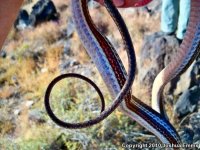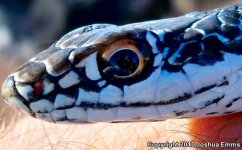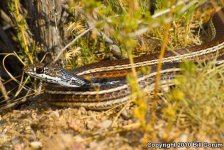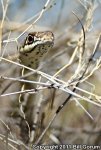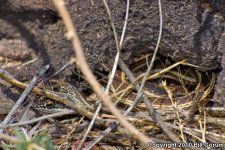Click on a picture to see a larger version in a different window
| Range: |
 |
| Other Names: |
|
| Subspecies: |
Coluber taeniatus taeniatus Desert Striped Whipsnake |
| Description: |
A long (up to 1,652 mm or 65" in total length), slender, dark brown, gray, or black snake with a prominent light stripe running the length of the body along each upper side. Thin, dashed, secondary stripes mark the lower sides. The primary stripes are yellow on the anterior portion of the body and grade to pale gray on the posterior half of the body. A thin black line runs down the center of each primary stripe on the anterior half of the body. The ventral surface is cream or white under the chin and neck, grading to yellow at mid-body, and dark pink under the tail. The eyes are large and the pupils are round. The scales are smooth. Stripes that run the length of its body and dark pink coloration under its tail distinguish this snake from the similar looking Sonoran Whipsnake. |
| Venom: |
None |
| Habitat: |
The Striped Whipsnake is primarily an inhabitant of Interior Chaparral, Great Basin Conifer Woodland, Plains Grassland, and Great Basin Grassland communities. It also enters the lower reaches of Petran Montane Conifer Forest in some areas. It inhabits a wide variety of terrain types including canyons, steep slopes, foothills, open plains, open plateaus, and riparian corridors. |
| Behavior: |
This diurnal, very fast moving, and alert snake is often seen cruising for food in the mid-morning sun. It often hunts with its head elevated off the ground. It is a good climber that often retreats into the branches of trees when threatened. It hibernates during the cold months of late fall and winter. It does not hesitate to bite when captured. |
| Hibernation: |
Rock crevices, known to communal hibernate with other species |
| Reproduction: |
Mating takes place in spring and a clutch of up to 12 eggs is laid in late spring or early summer. Hatchlings begin to emerge in August.
|
| Diet: |
lizards, snakes, mice and other small mammals, birds, frogs, and a variety of insects. |
Sources:

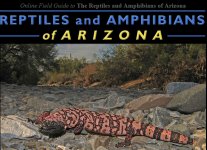
|




